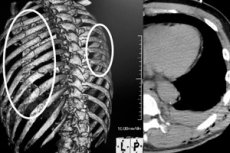Pericardial injury
Last reviewed: 24.08.2024

All iLive content is medically reviewed or fact checked to ensure as much factual accuracy as possible.
We have strict sourcing guidelines and only link to reputable media sites, academic research institutions and, whenever possible, medically peer reviewed studies. Note that the numbers in parentheses ([1], [2], etc.) are clickable links to these studies.
If you feel that any of our content is inaccurate, out-of-date, or otherwise questionable, please select it and press Ctrl + Enter.

First of all, pericardial wounds develop against the background of penetrating wounds of the thoracic cavity. This is often observed in mass disasters, accidents, emergencies. Damage is often of a mechanical nature. It should be noted that in most cases there are combined wounds, in which not only the pericardium itself is damaged, but also the pleural cavity, lung, heart itself, other adjacent structures. In clinical practice, isolated wounds in which only the pericardium was injured were observed only in 10% of cases.
Features of treatment, surgical tactics, prognosis are determined by the clinical picture, severity of the pathological process, as well as the localization and depth of injury. The simplest are isolated pericardial wounds, in which the wounds do not penetrate deeply and do not affect the myocardium. The most complex are deep penetrating wounds that affect the myocardium and damage the coronary vessels. Dangerous and damage to various internal structures of the heart, in particular, valves, septa. Severe pericardial wounds also include multiple wounds, needle wounds.
A wound larger than 1 cm is considered dangerous. Such a wound is accompanied by profuse bleeding, the wound is difficult to heal. Blood loss in such cases is significant. Immediate suturing of the pericardium is required. If suturing is not carried out as soon as possible, lethal outcome is possible.
Pericardial injury also needs to be diagnosed, as it is not always immediately identifiable. Clinical symptoms of pathology act as the main diagnostic measures. First, the wound is located in the area of the heart projection. Secondly, the boundaries of cardiac bluntness are significantly expanded. Heart tones become deaf, there is dyspnea, edema, congestion. There is a hemothorax, or fountain of blood from the wound site. It depends on what vessels are damaged. As significant signs that may indicate the development of a pericardial wound, subjective sensations such as suffocation, shortness of breath, arrhythmia and palpitations may also appear. Pallor of the skin appears, blood pressure drops sharply, cyanosis develops. But often the patient can not tell about his subjective sensations, as there is a sharp loss of consciousness, especially with the development of massive bleeding. A person is usually characterized by a distracted, indifferent appearance, even if he is conscious. He often does not respond to stimuli, is unable to answer questions, no concentration of attention is noted. The pupils may be dilated, the face is covered with profuse cold sweat. Many patients are in a state of clinical death at the time of admission to the hospital.
It is also important to pay attention to the nature of bleeding. Thus, in small wounds there are signs of hemotamponade or cardiac tamponade. In other cases, intrapleural bleeding is often observed, the volume of which can be quite large - up to 2-2.5 liters of blood loss. In this case, blood continuously flows from the wound. As a rule, it flows in a thin stream, and then the wound hole is quickly covered with a bloody film, blood foam is formed. Sometimes bleeding is so violent that it has the appearance of a huge fountain. This immediately suggests a heart wound.
A patient with pericardial wounds should be taken immediately to the hospital, to the surgical department. He needs immediate surgical intervention (often pericardial suturing). Before the patient is taken to the hospital, it is necessary to provide emergency care, at least clamping the wound to minimize blood loss. It is a good idea to have this done by an emergency physician. A temporary gauze swab can be applied to the wound area. With pericardial wounds, patients often gasp for breath, panic and inappropriate behavior are also possible. There are often cases when patients refuse help, behave aggressively, after which the face is covered with large drops of sweat, and the person loses consciousness.
As a rule, in patients with pericardial wounds, there is a sharp overstretching and severe tension of the pericardium. The pericardium at the site of the wound is dissected, on its surface sometimes forms a thrombolytic clot, most often localized in the area of the base. The wound may penetrate directly into the cavity. As clinical experience shows, if blood accumulates rapidly in the pericardium, and its volume exceeds 400-500 ml, it can lead to a fatal outcome. One of the unfavorable signs is the manifestation of congestive veins in the neck. Due to the fact that the blood loses a large amount of oxygen, ischemic processes in the brain, liver, kidneys are observed, which only aggravates the situation.
If the pericardium is traumatized in areas where major receptor areas are located and sensitivity is heightened, cardiac dysfunction, up to and including complete cardiac arrest, may occur.

